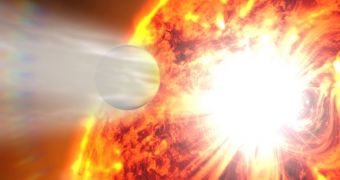Recent observations of the extrasolar planet HD 189733b, conducted using the American space agency's Hubble and Swift space telescopes, reveal significant changes taking place in the atmosphere surrounding this alien world.
One of the most remarkable things about this exoplanet is that it orbits at a distance of just 3 million miles (4.8 million kilometers) from the surface of its parent star. Since it's 14 percent larger and more massive than Jupiter, and extremely hot, astronomers classify it as a hot Jupiter.
This is among the first times ever when an international team of astronomers manages to observe atmospheric changes around another planet, outside of the solar system. According to the group, the modifications are caused by powerful solar eruptions of the star HD 189733.
These eruptions were first observed by the Swift spacecraft, which is what gave scientists the idea to use Hubble for subsequent observations. The study team was led by Paris Institute of Astrophysics (IAP) Principal Researcher, Alain Lecavelier des Etangs.
The IAP is part of the French National Scientific Research Center, which is itself located at the Pierre and Marie Curie University, in Paris. Lecavelier des Etangs says that the alien world is 30 times closer to its parent star than Earth is from the Sun.
As such, it completes a full orbit around the star (a year) in just 2.2 days. For comparison, the innermost planet in our own solar system (Mercury) takes 88 days to complete such a rotation.
“The multiwavelength coverage by Hubble and Swift has given us an unprecedented view of the interaction between a flare on an active star and the atmosphere of a giant planet,” the expert adds.
Scientists believe that this unique combination – a large planet orbiting close to a large star – provides the perfect setup to study atmospheric evaporation in a manner not possible in the solar system.
“Astronomers have been debating the details of atmospheric evaporation for years, and studying HD 189733b is our best opportunity for understanding the process,” concludes IAP PhD student and study team member, Vincent Bourrier.

 14 DAY TRIAL //
14 DAY TRIAL //